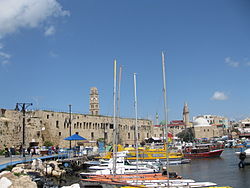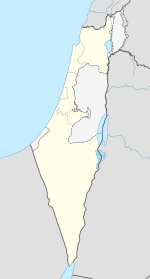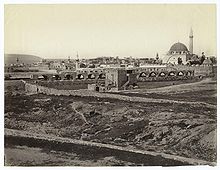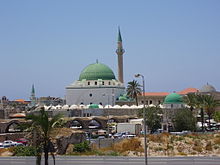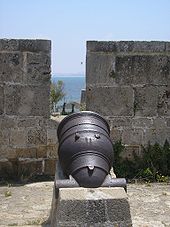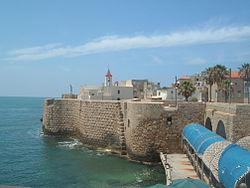- Acre, Israel
-
Acre Hebrew transcription(s) – Hebrew עַכּוֹ – ISO 259 ʕakko Arabic transcription(s) – Arabic عكّا 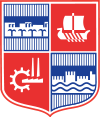
Municipal emblemCoordinates: 32°55′40″N 35°04′54″E / 32.92778°N 35.08167°ECoordinates: 32°55′40″N 35°04′54″E / 32.92778°N 35.08167°E District North Government – Type City – Mayor Shimon Lankri Area – Total 13,533 dunams (13.5 km2 / 5.2 sq mi) Population (2009)[1] – Total 46,300 Acre (Hebrew: עַכּוֹ, Akko; Arabic: عكّا, ʻAkkā),[2] is a city in the Western Galilee region of northern Israel at the northern extremity of Haifa Bay. Acre is one of the oldest continuously inhabited sites in the country.
Historically, it was a strategic coastal link to the Levant. Acre is the holiest city of the Bahá'í Faith.[3] In 2009, the population was 46,300.[1] Acre is a mixed city, 72 percent Jewish and 28 percent Arab. The mayor is Shimon Lankri, who was re-elected in 2011.[4]
Contents
History
Antiquity
Acre is one of the oldest continuously inhabited sites in Israel.[5] The name Aak, which appears on the tribute-lists of Thutmose III (c. 16th century BC), may be a reference to Acre.[citation needed] The Amarna letters also mention a place named Akka,[6] as well as the Execration texts, that pre-date them.[7] In the Hebrew Bible, (Judges 1:31), Akko is one of the places from which the Israelites did not drive out the Canaanites. It is later described in the territory of the tribe of Asher and according to Josephus, was ruled by one of Solomon's provincial governors. Throughout Israelite rule, it was politically and culturally affiliated with Phoenicia. Around 725 BC, Akko joined Sidon and Tyre in a revolt against Shalmaneser V.[8]
Greek and Roman periods
Greek historians refer to the city as Ake, meaning "cure." According to the Greek myth, Heracles found curative herbs here to heal his wounds.[9] Josephus calls it Akre. The name was changed to Antiochia Ptolemais shortly after Alexander the Great's conquest, and then to Ptolemais, probably by Ptolemy Soter, after the partition of the kingdom of Alexander the Great.[10]
Old City of Acre * UNESCO World Heritage Site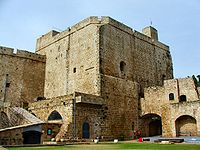
Country Israel Type Cultural Criteria ii, iii, v Reference 1042 Region ** Asia-Pacific Inscription history Inscription 2001 (25th Session) * Name as inscribed on World Heritage List
** Region as classified by UNESCOStrabo refers to the city as once a rendezvous for the Persians in their expeditions against Egypt. About 165 BC Judas Maccabeus defeated the Seleucids in several battles in Galilee, and drove them into Ptolemais. About 153 BC Alexander Balas, son of Antiochus Epiphanes, contesting the Seleucid crown with Demetrius, seized the city, which opened its gates to him. Demetrius offered many bribes to the Maccabees to obtain Jewish support against his rival, including the revenues of Ptolemais for the benefit of the Temple in Jerusalem, but in vain. Jonathan Maccabaeus threw in his lot with Alexander, and in 150 BC he was received by him with great honour in Ptolemais. Some years later, however, Tryphon, an officer of the Seleucids, who had grown suspicious of the Maccabees, enticed Jonathan into Ptolemais and there treacherously took him prisoner.
The city was captured by Alexander Jannaeus, Cleopatra VII of Egypt and Tigranes II of Armenia. Here Herod built a gymnasium, and here the Jews met Petronius, sent to set up statues of the emperor in the Temple, and persuaded him to turn back. St Paul spent a day in Ptolemais (Acts 21:7). A Roman colonia was established at the city, Colonia Claudii Cæsaris.[citation needed]After the permanent division of the Roman Empire in 395 CE, Akko was administered by the Eastern (later Byzantine) Empire.
Arab and Crusader periods
Following the defeat of the Byzantine army of Heraclius by the Muslim army of Khalid ibn al-Walid in the Battle of Yarmouk, and the capitulation of the Christian city of Jerusalem to the Caliph Umar, Acre came under the rule of the Arab caliphate beginning in 638. The Arab conquest brought a revival to the town of Acre, and it served as the main port of Palestine through the Umayyad and Abbasid Caliphates that followed, and through Crusader rule into the 13th century.[5] It was captured by King Baldwin I of Jerusalem in 1104 in the First Crusade and the Crusaders also made the town their chief port in Palestine.[11] Around 1170 it became the main port of the eastern Mediterranean, and the kingdom of Jerusalem was regarded in the west as enormously wealthy above all because of Acre. According to an English contemporary, it provided more for the Crusader crown than the total revenues of the king of England.[12] It was re-taken by Saladin in 1187, and unexpectedly besieged by Guy of Lusignan reinforced by Pisan naval and ground forces at first, in August 1189. But it was not captured until July 1191 by Richard I of England, Philip of France, Leopold of Austria, the spearhead Swabian and German armies and the rest of the crusader's army. It then became the capital of the remnant of the Kingdom of Jerusalem in 1192. In 1229 it was placed under the control of the Knights Hospitaller. The Crusaders called the city "Acre" or "Saint-Jean d'Acre" since they mistakenly identified it with the Philistine city of Ekron[citation needed], in northern Philistia, now southern Israel. It was the final stronghold of the Crusader state, and fell to the Mameluks of Egypt in a bloody siege in 1291.
Ottoman period
The Ottomans under Sultan Selim I captured the city in 1517, after which it fell into almost total decay. English academic Henry Maundrell in 1697 found it a ruin, save for a khan (caravanserai) occupied by some French merchants, a mosque and a few poor cottages.[13]
Towards the end of the 18th century it revived under the rule of Dhaher al-Omar, the local sheikh. His successor, Jezzar Pasha, governor of Damascus, improved and fortified it, but by heavy imposts secured for himself all the benefits derived from his improvements. About 1780 Jezzar peremptorily banished the French trading colony, in spite of protests from the French government, and refused to receive a consul.
In 1799 Napoleon, in pursuance of his scheme for raising a Syrian rebellion against Turkish domination, appeared before Acre, but after a siege of two months (March–May) was repulsed by the Turks, aided by Sir Sidney Smith and a force of British sailors. Having lost his siege cannons to Smith, Napoleon attempted to lay siege to the walled city defended by Ottoman troops on March 20, 1799, using only his infantry and small-calibre cannons, a strategy which failed, leading to his retreat two months later on May 21.
Jezzar was succeeded on his death by his son Suleiman Pasha, under whose milder rule the town advanced in prosperity till his death in 1819. After his death, Haim Farhi, who was his adviser, paid a huge sum in bribes to assure that Abdullah Pasha (son of Ali Pasha, the deputy of Suleiman Pasha), whom he had known from youth, will be appointed as ruler. Abdullah Pasha ruled Acre until 1831, when Ibrahim Pasha besieged and reduced the town and destroyed its buildings. During the Oriental Crisis of 1840 it was bombarded on November 4, 1840 by the allied British, Austrian and French squadrons, and in the following year restored to Turkish rule.
British Mandate
At the beginning of the Mandate period, in 1922, Acre had about 6,500 residents: 4883 of whom Muslim, 1344 Christian, 115 Baha’i, and 78 Jewish.[14] The British Mandate government reconstructed Acre and its economic situation improved. The 1931 Mandate census counted 7,897 people in Acre. In 1946 Acre’s population numbered around 13,000.[14]
During the pogrom of 1929, Arabs, led by Sheikh Ass’ad Shukairy, demolished the ancient synagogue in Acre’s old city.[14] During the Arab revolt in 1936–1939, Acre’s Arab residents were very active against the British and the Jewish settlements in Western Galilee.[14] This caused the Jews to leave Acre.
Acre’s fort was converted into a jail, where members of the Jewish underground were held during their struggle against the British, among them Zeev Jabotinski, Shlomo ben Yossef, and Dov Grunner. Grunner and ben Yossef were executed there. Other Jewish inmates were freed by members of the Irgun, who broke into the jail on May 4, 1947 and succeeded in releasing Jewish underground movement activists. Over 200 Arab inmates also escaped.[15]
In the 1947 UN Partition Plan, Acre was designated part of a future Arab state. Before the Arab invasion into Palestine broke out, Acre’s Arabs attacked neighbouring Jewish settlements and Jewish transportation. On March 18, 1948, Arabs from Acre murdered Jewish employees of the electricity company who were repairing the damaged lines near the city.
During the war of 1948, Acre was besieged by Israeli forces. A typhoid fever outbreak occurred in Acre at this time.[citation needed] Egypt claimed that the Haganah used typhus as a biological weapon against the inhabitants, though no evidence was forwarded in favour of the claim.[citation needed] Brigadier Beveridge, chief of the British medical services, proclaimed at the time that "Nothing like that ever happened in Palestine". According to Ilan Pappé, investigation by Beveridge, Colonel Bonnet of the British army and delegates of the Red Cross concluded that the infection was caused by water-borne sources.[16] Israel denies it has ever used biological weapons.[17][18]
State of Israel
Acre was captured by Israel on May 17, 1948,[19] displacing about three-quarters of the Arab population of the city (13,510 of 17,395).[20] Throughout the 1950s many Jewish neighbourhoods were established at the northern and eastern parts of the city, as it became a development town, designated to absorb numerous Jewish immigrants, largely Jews from Morocco. The old city of Akko remained largely Arab Muslim (including several Bedouin families), with Arab Christian neighbourhood in close proximity. The city also attracted many Bahai worshippers, some of whom became permanent residents in the city, where the Bahai Mansion of Bahjí is located.
In the 1990s the city absorbed thousands of Jews, who immigrated from the Soviet Union and later from Russia and Ukraine. Within several years, however, the population balance between Jews and Arabs shifted backwards, as northern neighbourhoods were abandoned by many of its Jewish residents in favor of new housing projects in nearby Nahariya, while many Muslim Arabs moved in (largely coming from nearby Arab villages). Nevertheless, the city still has a clear Jewish majority (72 percent).
Ethnic tensions erupted in the city on October 8, 2008 after an Arab citizen drove through a predominantly Jewish neighbourhood during Yom Kippur, leading to five days of violence.[21][22][23]
In 2009, the population of Acre reached 46,300.[1] The current mayor Shimon Lankri was re-elected in 2011.[4]
Demography
According to the Israeli Central Bureau of Statistics, there are 46,300 citizens in Acre. Acre's population is mixed with Jews, Muslims and Christians, with small minorities of Druzes and Baha'i. Jews are 67.1% of the city's population, Muslim Arabs are 25.3% of the city's population, Christian Arabs are 2.4% of the city's population and other citizens make up 5.2% of the city's population.
According to the Israeli Central Office of Statistics, 95% of the residents in the Old City are Arab.[24] Only about 15 percent of the current Arab population in the city descends from families who lived there before 1948.[25] Schools for Arab citizens have been underfunded.[citation needed] In 1999, there were 22 schools in Acre with an enrollment of 15,000 children.[26] In 2000 there was only one Arab elementary school in the city.[27][dubious ]
Education and culture
The Sir Charles Clore Jewish-Arab Community Center in the Wolfson neighborhood runs youth clubs and programs for Jewish and Arab children. In 1990, Mohammed Faheli, an Arab resident of Acre, founded the Acre Jewish-Arab association, which originally operated out of two bomb shelters. In 1993, Dame Vivien Duffield of the Clore Foundation donated funds for a new building. Among the programs offered is Peace Child Israel, which employs theater and the arts to teach coexistence. The participants, Jews and Arabs, spend two months studying conflict resolution and then work together to produce an original theatrical performance that addresses the issues they have explored. Another program is Patriots of Acre, a community responsibility and youth tourism program that teaches children to become ambassadors for their city. In the summer, the center runs an Arab-Jewish summer camp for 120 disadvantaged children aged 5–11. Some 1,000 children take part in the Acre Center's youth club and youth programming every week. Adult education programs have been developed for Arab women interested in completing their high school education and acquiring computer skills to prepare for joining the workforce. The center also offers parenting courses, and music and dance classes.[28]
Landmarks
Acre's Old City has been designated by UNESCO as a World Heritage Site. Since the 1990s, large-scale archeological excavations have been undertaken and efforts are being made to preserve ancient sites. In 2009, renovations were planned for Khan al-Omadan, the Inn of the Columns", the largest of several Ottoman inns still standing in Acre. It was built near the port at the end of the 18th century by Ahmed Pasha al-Jazzar. Merchants who arrived at the port would unload their wares on the first floor and sleep in lodgings on the second floor. In 1906, a clocktower was added over the main entrance marking the 25th anniversary of the reign of the Turkish sultan, Abdul Hamid II.[29]
City walls
In 1750, Daher El-Omar, the ruler of Acre, utilized the remnants of the Crusader walls as a foundation for his walls. Two gates were set in the wall, the "land gate" in the eastern wall, and the "sea gate" in the southern wall. The walls were reinforced between 1775 and 1799 by Jezzar Pasha and survived Napoleon's siege. The wall was thin: its height was 10 to 13 metres (33 to 43 feet) and its thickness only one metre (3 ft). A heavy land defense wall was built north and east to the city in 1800–1814 by Jezzar Pasha and his Jewish advisor Haim Farhi. It consists of a modern counter artillery fortification which includes a thick defensive wall, a dry moat, cannon outposts and three burges (large defensive towers). Since then, no major modifications have taken place. The sea wall, which remains mostly complete, is the original El-Omar's wall that was reinforced by Jezzar Pasha. In 1910 two additional gates were set in the walls, one in the northern wall and one in the north-western corner of the city. In 1912 the Acre lighthouse was built on the south-western corner of the walls.
Jezzar Pasha Mosque
The Mosque of Jezzar Pasha was built in 1781. Jezzar Pasha and his successor Suleiman Pasha, are both buried in a small graveyard adjacent to the mosque. In a shrine on the second level of the mosque, a single hair from the prophet Mohammed's beard is kept and shown on special ceremonial occasions.
Citadel of Acre
The current building which constitutes the citadel of Acre is an Ottoman fortification, built on the foundation of the Hospitallerian citadel. The citadel was part of the city's defensive formation, reinforcing the northern wall. During the 20th century the citadel was used mainly as a prison and as the site for a gallows. During the British mandate period, activists of Jewish Zionist resistance movements were held prisoner there; some were executed there.
Hamam al-Basha
Built in 1795 by Jezzar Pasha, Acre's hammam has a series of hot rooms and a hexagonal steam room with a marble fountain. It was used by the Irgun as a bridge to break into the citadel's prison. The bathhouse kept functioning until 1950.
Knights' Halls
Under the citadel and prison of Acre, archaeological excavations revealed a complex of halls, which was built and used by the Hospitallers Knights.[11] This complex was a part of the Hospitallers' citadel, which was combined in the northern wall of Acre. The complex includes six semi-joined halls, one recently excavated large hall, a dungeon, a dining room and remains of an ancient Gothic church. Medieval European remains include the Church of Saint George and adjacent houses at the Genovese Square (called Kikar ha-Genovezim or Kikar Genoa in Hebrew). There were also residential quarters and marketplaces run by merchants from Pisa and Amalfi in Crusader and medieval Acre.
Bahá'í holy places
There are many Bahá'í holy places in and around Acre. They originate from Bahá'u'lláh's imprisonment in the Citadel during Ottoman Rule. The final years of Bahá'u'lláh's life were spent in the Mansion of Bahjí, just outside Acre, even though he was still formally a prisoner of the Ottoman Empire. Bahá'u'lláh died on May 29, 1892 in Bahjí, and his shrine is the most holy place for Bahá'ís — their Qiblih, the location they face when saying their daily prayers. It contains the remains of Bahá'u'lláh and is near the spot where he died in the Mansion of Bahjí. Other Bahá'í sites in Acre are the House of `Abbúd (where Bahá'u'lláh and his family resided) and the House of `Abdu'lláh Páshá (where later 'Abdu'l-Bahá resided with his family), and the Garden of Ridván where he spent the end of his life. In 2008, the Bahai holy places in Acre and Haifa were added to the UNESCO World Heritage List.[30][31]
Sports
The city's football team Hapoel Acre is a member of Liga Leumit, the second tier of Israeli football, after a brief stint in the Ligat ha'Al top division during the 1970s. At the end of the 2008/9 season Hapoel Acre finished in the top five and so was promoted to the Ligat ha'Al for a second time, after an absence of 31 years. A new football stadium is under construction at the southern approaches to the city and it is hoped that it will open during the 2011/2012 season and will seat 5000 spectators.
Transportation
The Acre central bus station, served by Egged, offers city and inter-city bus routes to destinations all over Israel. The city is also served by the Acre Railway Station.
Twin towns — Sister cities
Acre is twinned with:
 Pisa, Italy, since 1998 [32]
Pisa, Italy, since 1998 [32] Bregenz, Austria
Bregenz, Austria La Rochelle, France, since 1972[33]
La Rochelle, France, since 1972[33] Recklinghausen, Germany
Recklinghausen, Germany Bielsko-Biała, Poland[34]
Bielsko-Biała, Poland[34] Canton, United States
Canton, United States Deerfield Beach, United States
Deerfield Beach, United States
Notable residents
- Delila Hatuel, Olympic foil fencer
- Heinrich Walpot von Bassenheim
- Otto von Kerpen
- Louis-Marie-Joseph Maximilian Caffarelli du Falga
See also
References
- ^ a b c "Table 3 – Population of Localities Numbering Above 2,000 Residents and Other Rural Population". Israel Central Bureau of Statistics. December 31, 2009. http://www.cbs.gov.il/population/new_2010/table3.pdf. Retrieved February 6, 2011.
- ^ Other spellings and historical names of the city include Accho, Acco and (Bahá'í orthography) `Akká, or formerly Aak, Ake, Akre, Akke, Ocina, Antiochia Ptolemais (Greek: Αντιόχεια της Πτολεμαΐδος), Antiochenes, Ptolemais Antiochenes, Ptolemais or Ptolemaïs, Colonia Claudii Cæsaris, and St.-Jean d'Acre (Acre for short)
- ^ Jerry Stokes. Changing World Religions, Cults & Occult. Jerry Stokes. p. 410. GGKEY:7PKT22E2TP3. http://books.google.com/books?id=DTPJpanTizwC&pg=PA410. Retrieved October 19, 2010.
- ^ a b Interview with Acre Mayor Shimon Lankri
- ^ a b Andrew Petersen (February 6, 2002). A Gazetteer of Buildings in Muslim Palestine: Volume I (British Academy Monographs in Archaeology) (Pt.1) (Hardcover). British Academy. p. 68.
- ^ Burraburias II to Amenophis IV, letter No. 2
- ^ Aharoni, Yohanan (1979). The land of the Bible: a historical geography. Westminster John Knox Press. pp. 144–147. ISBN 9780664242664. http://books.google.com/books?id=AMtoyNxWw0UC&pg=PA144. Retrieved October 18, 2010.
- ^ Becking Bob (1992) The Fall of Samaria: An Historical and Archaeological Study BRILL, ISBN 9004096337 pp 31–35
- ^ The Guide to Israel, Zev Vilnay, Ahiever, Jerusalem, 1972, p. 396
- ^ "Acco, Ptolemais, Acre". BiblePlaces.com. http://www.bibleplaces.com/acco.htm. Retrieved October 20, 2008.
- ^ a b "Archaeology in Israel – Acco (Acre)". Jewishmag.com. http://www.jewishmag.com/30MAG/acco/acco.htm. Retrieved May 5, 2009.
- ^ Jonathan Riley-Smith, University of Cambridge. "A History of the World – Object : Hedwig glass beaker". BBC. http://www.bbc.co.uk/ahistoryoftheworld/objects/2GL6QSA8SMmcMCtPgHQJsw. Retrieved September 15, 2011.
- ^ Maundrell, Henry (1836). A Journey from Aleppo to Jerusalem: At Easter, A.D. 1697. S. G. Simkins. p. 90. http://books.google.com/?id=LG09AAAAMAAJ&printsec=titlepage. Retrieved October 20, 2008.
- ^ a b c d Rivka Spak Lissak. Acre Has Been Settled by Jews Alternately Since the 3rd Century BCE. [1]
- ^ "Acre Jail Break". Britain's Small Wars. http://www.britains-smallwars.com/Palestine/Acre.htm. Retrieved October 20, 2008.
- ^ Pappé, Ilan, The Ethnic Cleansing of Palestine (2007), p. 100
- ^ "Typhoid – Biological Weapons". GlobalSecurity.org. http://www.globalsecurity.org/wmd/intro/bio-typhoid.htm. Retrieved October 20, 2008.
- ^ "Israel: Biological Chronology". Nuclear Threat Initiative. http://www.nti.org/e_research/profiles/Israel/Biological/3652.html. Retrieved October 20, 2008.[dead link]
- ^ Operation Ben-Ami
- ^ Karsh (2010), p. 268
- ^ Khoury, Jack (October 13, 2008). "Peres in Acre: In Israel There Are Many Religions, But Only One Law". Haaretz. http://www.haaretz.com/hasen/spages/1028604.html. Retrieved October 20, 2008.
- ^ Kershner, Isabel (October 12, 2008). "Israeli City Divided by Sectarian Violence". New York Times. http://www.nytimes.com/2008/10/13/world/middleeast/13mideast.html?bl&ex=1224043200&en=1694b9dd225b8c71&ei=5087%0A. Retrieved October 20, 2008.
- ^ Izenberg, Dan (October 12, 2008). "Police Arrest Acre Yom Kippur driver". The Jerusalem Post. http://fr.jpost.com/servlet/Satellite?cid=1222017521503&pagename=JPost/JPArticle/ShowFull. Retrieved October 20, 2008.
- ^ http://www.cbs.gov.il/www/statistical/arabju.pdf
- ^ Stern, Yoav. "For Love of Acre". Haaretz. http://www.haaretz.com/hasen/spages/1024906.html. Retrieved October 20, 2008.
- ^ Cooperative Learning in Israel's Jewish and Arab Schools
- ^ Torstrick Rebecca L. (2000) The Limits of Coexistence: Identity Politics in Israel University of Michigan Press, ISBN 0472111248 p.219
- ^ Ambassadors for peace emerging from mixed Israeli neighborhood
- ^ Unearthing Acre's Ottoman roots
- ^ "Baha'i Shrines Chosen as World Heritage sites". Baha'i World News Service. July 8, 2008. http://www.bwns.org/story/642. Retrieved October 20, 2008.
- ^ Glass, Hannah (July 10, 2008). "Israeli Baha'i Sites Recognized by UNESCO". Haaretz. http://www.haaretz.com/hasen/spages/1000944.html. Retrieved October 20, 2008.
- ^ "Pisa – Official Sister Cities". © Comune di Pisa, Via degli Uffizi, 1 – 56100 Pisa centralino: +39 050 910111. http://www.comune.pisa.it/english/doc/gemhome.htm. Retrieved December 16, 2008.
- ^ "La Rochelle: Twin towns". www.ville-larochelle.fr. http://www.ville-larochelle.fr/en/decouvrir-la-ville/villes-jumelles.html. Retrieved November 7, 2009.
- ^ "Bielsko-Biała – Partner Cities". © 2008 Urzędu Miejskiego w Bielsku-Białej.. http://www.um.bielsko.pl/. Retrieved December 10, 2008.
Bibliography
- Karsh, Efraim (2010). Palestine Betrayed. Yale University Press. ISBN 978-0-300-12727-0.
External links
- Official website of the Old City of Acre
- Acre's History (Jewish Virtual Library)
- Acre travel home page (TripTouch.com)
- Names by which Acre has been known & pictures (Bibleplaces.com)
- Hazlitt's Classical Gazetteer
- The Tourists Guide to Acre
- Photo gallery of the old city of Acco
World Heritage Sites in Israel and East Jerusalem Israel Old City of Acre · Bahá’i Holy Places in Haifa and Western Galilee · Incense Route – Desert Cities in the Negev (Avdat, Haluza, Mamshit and Shivta) · Masada · Biblical Tells (Tel Be'er Sheva, Tel Hazor, Tel Megiddo) · White City of Tel AvivEast Jerusalem Third Journey of Paul the Apostle Phoenician cities and colonies Algeria: Hippo Regius · Ikosium · Guelma · Iol · Rus Icada · Rus Azuz · Iom · Honaine · Pomoria · Cirta · Rus Ucurru · Rus Aghoun · Rus Ipir · Qart Ina · Siga · Timgad · Lambese · Djémila · Uzinaza · Cuicul · Altava · Igligili · Imonium · Sitifis · Auzia · Rapidum · Portus Magnus · Tipaza · Cyprus: Kition · Italy: Karalis · Lilybaeum · Motya · Nora · Olbia · Panormus · Solki · Soluntum · Tharros · Lebanon: Amia · Ampi · Arqa · Baalbek · Berut · Botrys · Gebal · Sarepta · Sur · Sydon · Tripolis · Libya: Leptis Magna · Oea · Sabratha · Malta: Gozo · Mauritania: Cerne · Morocco: Arambys · Caricus Murus · Lixus · Tingis · Portugal: Olissipona · Ossonoba · Spain: Abdera · Abyla · Akra Leuke · Gadir · Herna · Ibossim · Mahón · Malaca · Onoba · Qart Hadašt · Rusadir · Sexi · Syria: Amrit · Arwad · Safita · Ugarit · Tunisia: Carthage · Hadrumetum · Hippo Diarrhytos · Kerkouane · Leptis Parva · Thanae · Thapsus · Utica · Turkey: Myriandrus · Phoenicus · Gibraltar
Categories:- North District (Israel)
- World Heritage Sites in Israel
- Acre, Israel
- Daher al-Omar fortifications
- Holy cities
- Mixed Israeli communities
Wikimedia Foundation. 2010.

